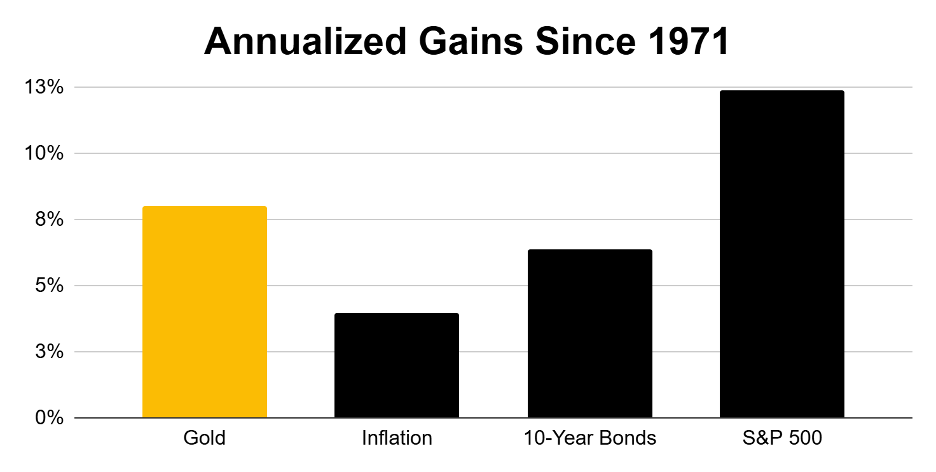Since the abandonment of the gold standard in 1971, the yellow metal has grown by 8% year over year. This return outpaces annualized bonds and competes with equities, the preferred growth asset among US investors. The World Gold Council (WGC), the leading authority in the market, analyzed gold’s performance over the past 54 years to better understand what it offers in an economic system with no formal precious metals foundation. The results show that gold not only preserves wealth but also holds the potential for substantial returns.1
Gold Shines Since 1971
Analysts at the WGC examined data from more than five decades of performance across a spectrum of assets, and the results are making investors reconsider their attitude toward gold.

Gold vs. Inflation
Gold’s impressive 8% annualized return is dramatically higher than the standard expectation that it will keep pace with inflation. For reference, the average inflation rate has been 3.95% since 1971. That means gold has grown at twice the inflation rate, providing investors with a considerable protective barrier against the corrosive aspects of currency devaluation.
Gold vs Bonds
Furthermore, gold’s rate of return far exceeds bond averages, which hover between 4% and 6%. For instance, 3-month T-bills have averaged 4.41% annually since 1971, while 10-year US Treasury bonds have returned 6.38% over the same period. Thus, gold outperforms what investors often consider the most stable government-issued assets by 2% to 4%.
Gold vs Stock Market
Perhaps most surprisingly, gold’s annualized returns since the gold standard’s demise have held their own against the S&P 500. Since 1971, the S&P 500 has delivered a 12.42% annualized return—just over 4% higher than gold’s. This is significant given that gold is traditionally seen as a safe-haven asset, while the S&P 500 is considered the nation’s primary growth engine.
👉 Related Read: Gold vs Stock Market: Comparing These Popular Investment Options
Dual Function = Dual Demand
Gold’s performance is often viewed as one-dimensional. Its value rises primarily when traditional assets like the stock market and the dollar decline. While it has long been established as a safe-haven asset, the WGC highlights another crucial role—one supported by its 8% annualized returns.
Beyond investment demand, gold prices also benefit from industrial and consumer demand driven by the technology and jewelry sectors. This diverse consumption helps sustain gold prices, regardless of economic conditions, explaining how the yellow metal can average 8% growth yearly through bearish and bullish markets.
As WGC explains, “Diverse sources of demand give gold a particular resilience and the potential to deliver solid returns in various market conditions.”
Gold Demand Steadily Increases
The end of the gold standard could have been the death knell for gold as a commodity. Over time, however, the failings of a baseless fiat currency system have fueled a modern-day gold rush as national, institutional, and retail investors seek to secure their wealth.
In 2024, central bank gold demand reached over 1,000 tons for the third straight year, underscoring the momentum behind these bulk purchases. The corollary to this sustained, record-breaking demand is higher gold prices. Experts have set optimistic gold price forecasts for 2025 with many anticipating the yellow metal to hit $3,000 and beyond, primarily driven by robust demand.


